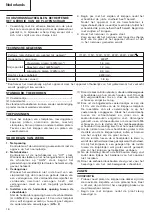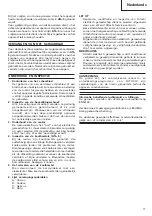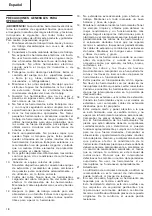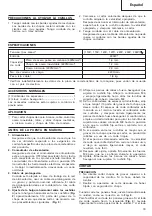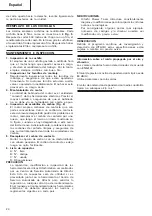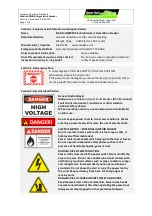
5
English
4. Inspecting the carbon brushes (Fig. 6)
The motor employs carbon brushes which are
consumable parts. Since an excessively worn carbon
brush can result in motor trouble, replace the carbon
brush with a new one having the same carbon
brush No. shown in the figure when it becomes
worn to or near the “wear limit”. In addition, always
keep carbon brushes clean and ensure that they
slide freely within the brush holders.
5. Replacing carbon brushes
Disassemble the brush cap with a screwdriver. The
carbon brush can then be easily removed.
6. Service parts list
A: Item No.
B: Code No.
C: No. Used
D: Remarks
CAUTION
Repair, modificatio}–and inspection of Hitachi Power
Tools must be carried out by an Hitachi Authorized
Service Center.
This Parts List will be helpful if presented with the
tool to the Hitachi Authorized Service Center when
requesting repair or other maintenance.
In the operation and maintenance of power tools,
the safety regulations and standards prescribed in
each country must be observed.
MODIFICATIONS
Hitachi Power Tools are constantly being improved
and modified to incorporate the latest technological
advancements.
Accordingly, some parts (i.e. code numbers and/or
design) may be changed without prior notice.
NOTE
Due to HITACHI’s continuing program of research and
development, the specifications herein are subject to
change without prior notice.
IMPORTANT
Correct connection of the plug
The wires of the main lead are coloured in accordance
with the following code:
Blue: -Neutral
Brown: -Live
As the colours of the wires in the main lead of this tool
may not correspond with the coloured markings
identifying the terminals in your plug proceed as follows:
The wire coloured blue must be connected to the terminal
marked with the letter N or coloured black. The wire
coloured brown must be connected to the terminal mark-
ed with the letter L or coloured red. Neither core must be
connected to the earth terminal.
NOTE
This requirement is provided according to BRITISH
STANDARD 2769: 1984.
Therefore, the letter code and colour code may not
be applicable to other markets except The United
Kingdom.
Information concerning airborne noise and vibration
The measured values were determined according to
EN50144.
The typical A-weighted sound pressure level: 80 dB (A).
Wear ear protection.
The typical weighted root mean square acceleration
value does not exceed 2.5m/s
2
.
Summary of Contents for CE 16
Page 29: ...28 ...
Page 31: ...30 1 2 3 4 5 ...

















